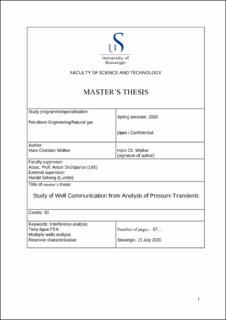| dc.contributor.advisor | Shchipanov, Anton | |
| dc.contributor.advisor | Selseng, Harald | |
| dc.contributor.author | Walker, Hans Christian | |
| dc.date.accessioned | 2020-10-28T11:48:58Z | |
| dc.date.available | 2020-10-28T11:48:58Z | |
| dc.date.issued | 2020-07-15 | |
| dc.identifier.uri | https://hdl.handle.net/11250/2685488 | |
| dc.description | Master's thesis in Petroleum engineering | en_US |
| dc.description.abstract | On 5th October 2019, one of the largest oil fields discovered in recent years on the Norwegian continental shelf started its production from the Utsira high formation. The field is called Johan Sverdrup and is considered pivotal not just for the partners involved, but for the whole Norwegian petroleum industry when it comes to creating jobs and revenue. Since the field has just started to produce and because of its geological structure and size, there are some uncertainties regarding sand thickness and permeability. Papers published on the field reported permeability ranged from 1 to 70 Darcy because the rock is made up of unconsolidated sand. It is important to estimate these two properties applying different methods because they are important for evaluating how much hydrocarbons the field will produce in the future. Seismic data from the field indicate there are many faults present in the reservoir, yet there has been observation of communication between faults. Drill Stem Tests (DST) from exploration wells may also indicate communication across the faults. One way to estimate properties of the reservoir along with identifying characteristics of the faults is by analysing all pressure transient data available for the field. This includes initial well tests such as DSTs, specially designed and performed well interference tests during production and reviewing the variety of pressure transient data available for production and shut-in periods as measured by Permanent Downhole Gauges. Pressure Transient Analysis (PTA) is the tool to address all the data.
The purpose of this thesis is to investigate what values of permeability and sand thickness we can obtain by interpreting different pressure transients. In our study, the interference test interpretation is the starting point providing base-line values for permeability and pay thickness as well as cross-fault leakage. DST interpretation is used for verifying these values and time-lapse PTA is employed to see the applicability of these values in reproducing the whole history of production, where well interference becomes the driving factor for pressure transient responses. In addition, these PTA methods are used to identify boundaries like faults dividing the field into compartments, and their flowing conditions (sealing or conductive faults). It was observed in the thesis that neighboring wells had an impact on the interference tests and had to be taken into account in the analyses. Furthermore, geological data are integrated into the analysis to see if the results obtained are sensible in relation to reported data. Observation from the interference analysis and time-lapse PTA indicates that the area of interest has a sand thickness around 29-30 meters and a range of permeability from 27D to 34D. A leakage factor for the fault in focus at 0.25 was identified with interference tests. The time-lapse PTA with a numerical reservoir model with multiple wells was able to match most of the transient periods of the wells. This indicates that there is communication between the wells and the reservoir model integrates major reservoir features like faults in the area of interest. However, the model is only limited to the northern part of the reservoir providing some mismatch of the observations. A further study with added wells from south is recommended. Finally, two compressibility values were looked into to see which one best matched the pressure responses along with being aligned with other geological data sources. | en_US |
| dc.language.iso | eng | en_US |
| dc.publisher | University of Stavanger, Norway | en_US |
| dc.relation.ispartofseries | Masteroppgave/UIS-TN-IEP/2020; | |
| dc.subject | petroleumsteknologi | en_US |
| dc.subject | reservoarteknologi | en_US |
| dc.title | Study of Well Communication from Analysis of Pressure Transients | en_US |
| dc.type | Master thesis | en_US |
| dc.subject.nsi | VDP::Teknologi: 500::Berg‑ og petroleumsfag: 510::Petroleumsteknologi: 512 | en_US |
